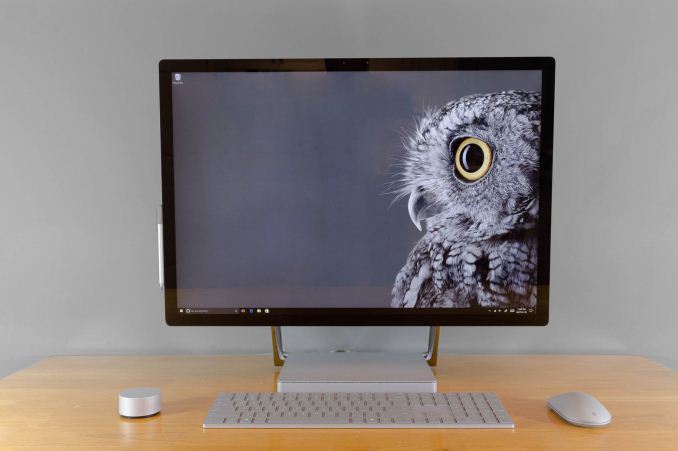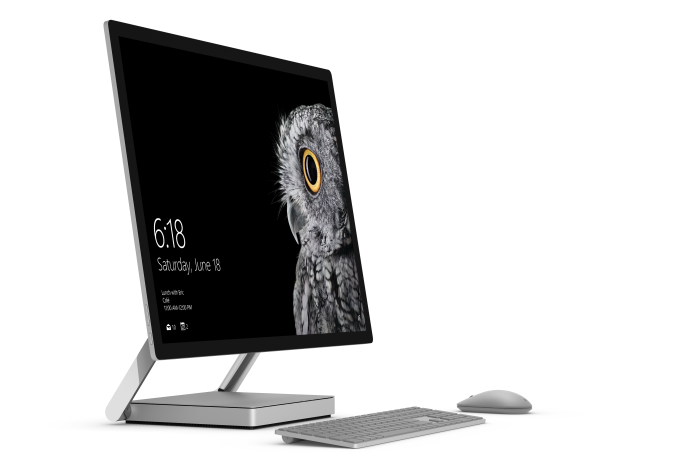The Microsoft Surface Studio Review
by Brett Howse on January 20, 2017 8:00 AM EST- Posted in
- Desktop
- Microsoft
- Surface
- Surface Studio

Microsoft has only been in the PC system game for a few years now, but over the last couple of years they have made a lot of progress rather quickly. These days they have a solid foundation of products available, with the Surface Pro 4 being one of the best convertible tablets, the Surface Book being a very solid convertible laptop, and also the more specialized products like the Hololens, and Surface Hub. Going into their October 2016 event, the one missing piece of their PC product lineup was a desktop computer, but with the announcement and release of the Surface Studio, that particular gap has now been filled.
But the Surface Studio is not your typical desktop PC. Even at first glance, the sleek, beautiful lines are readily apparent, and once powered on, it is rare for anyone to first glimpse the 28.125-inch 4500x3000 display and not say “wow”. It’s not only the very high resolution, but also the 3:2 aspect ratio that is unheard of in this segment, that makes the display stand out as something unique.
Microsoft has become one of the superlative hardware manufacturers in only the short span of four years or so, and the Surface Studio is one of their finest designs yet. However, from the very first Surface RT, Microsoft always tries to add something different, but more importantly interesting, to their designs, and in the case of the Surface Studio, it is the zero-gravity hinge, which allows the all-in-one to be quickly and easily tilted back to a 20° angle, letting it be used as a huge, digital drafting table. Microsoft announced the Surface Studio at their October Windows event, where they also announced the next Windows 10 Update, called the Creator’s Update, and it is wonderful to see them building hardware to truly bring out the exclusive features of their software.
Packed into the base of the Surface Studio is a laptop-class computer, with three different models available now. The base model, coming in at $2999, features an Intel Core i5-6440HQ processor, 8 GB of memory, a 1 TB hybrid drive with a 64 GB SSD cache, and a NVIDIA GeForce GTX 965M GPU. The mid-level model, which costs $3499, bumps the CPU up to an Intel Core i7-6820HQ, doubles the RAM to 16 GB, and doubles the SSD cache to a PCIe 128 GB model, with the same 1 TB HDD and GTX 965M. The highest priced model, at $4199, is an Intel Core i7-6820HQ, 32 GB of RAM, a 2 TB hybrid drive with a 128 GB PCIe cache, and a NVIDIA GTX 980M GPU with 4 GB of memory.
| Microsoft Surface Studio | ||||||
| Base | Middle | Top (As Tested) | ||||
| CPU | Intel Core i5-6440HQ Quad-Core, 2.6-3.5 GHz 6 MB Cache, 45W TDP, No Hyperthreading |
Intel Core i7-6820HQ Quad-Core, 2.7-3.6 GHz 8 MB Cache, 45W TDP, Hyperthreading |
||||
| GPU | NVIDIA GTX 965M 1024 CUDA Cores 944 Mhz + Boost 2 GB GDDR5 128-bit memory |
NVIDIA GTX 980M 1536 CUDA Cores 1038 Mhz + Boost 4 GB GDDR5 256-bit memory |
||||
| RAM | 8 GB DDR4 | 16 GB DDR4 | 32 GB DDR4 | |||
| Storage | 1 TB Hybrid Drive 64 GB SATA SSD Cache / 1 TB SATA HDD |
1 TB Hybrid Drive 128 GB PCIe SSD Cache / 1 TB SATA HDD |
2 TB Hybrid Drive 128 GB PCIe SSD Cache / 2 TB SATA HDD |
|||
| IO | 4 USB 3.0 ports - one high power port Full size SD Card Slot Headset Jack Xbox Wireless Connectivity DisplayPort |
|||||
| Display | 28.125-inch PixelSense Display 4500 x 3000 resolution 192 DPI sRGB, DCI-P3, P3 D65 color modes |
|||||
| Webcam | 5 MP Webcam Windows Hello Facial Recognition |
|||||
| Networking | Marvel AVASTAR 802.11ac Intel I219-LM Gigabit Ethernet |
|||||
| Price | $2,999 | $3,499 | $4,199 | |||
There was quite a bit of discussion at the time of the Surface Studio launch over the fact that it was equipped with older technology. Intel’s Kaby Lake quad-core parts just launched at CES this year, so Skylake quad-core CPUs were the latest generation available at launch. The Maxwell based graphics options chosen were not the latest generation mobile graphics from NVIDIA, with the GTX 965M and GTX 980M available in the Studio. The Pascal based GTX 1060 and GTX 1070 would have been much more powerful substitutes, but they are not pin-compatible drop-in components with the Maxwell GPUs in the Surface Studio, meaning a new board design and thermal considerations would have been necessary late in the design phase, and Microsoft appears to have been conservative here to avoid missing their launch window.
Microsoft has also been very conservative with their I/O choices, with four USB 3.0 Type-A ports on the back of the Studio, along with a SD card slot, and mini DisplayPort. As with the Surface Pro 4 and Surface Book, Microsoft has continued to provide only the older USB-A ports, and not even offer a single USB-C port, let alone with Thunderbolt. Anyone purchasing a Studio will likely be using it for several years, and the lack of USB-C is going to be an issue in the future, if not already today. The Surface team really needs to reconsider this as it is already a detriment to not include any.
There also must be some questions raised about the use of a hybrid drive in a PC of this price. We’ll dig in to the experience later, but Microsoft could and should offer a larger SSD as the boot disk, complimented by a HDD as a secondary disk, at least on the highest end model. A 512 GB NVMe SSD as the boot drive would appease much of the criticism. The computer does cost over $4000 after all, and while much of the cost of the device is in the display, SSDs have been the biggest improvement in user experience on the PC in a long time.











197 Comments
View All Comments
Brett Howse - Friday, January 20, 2017 - link
It also has a much smaller, lower resolution display, without touch support.BillBear - Friday, January 20, 2017 - link
That doesn't become worthless when you need to upgrade the computer's hardware.If you're going to make something this expensive, yet disposable due to a lack of hardware upgradability, it needs to at least be on par with existing professional drawing tools. Wacom's pen is much more advanced, it's color management is much more advanced, and the Express Key Remote is much more advanced than the Surface Dial.
Also, I'm not sure where you get the notion that Wacom's products can not support multitouch.
jlabelle2 - Sunday, January 22, 2017 - link
How does this "double pressure" sensitivity translates in real world?Let's imagine that you have 1024 level of pressure, and that the max displacement of the screen would be 1mm when pressing fully, it means that 1 increment of level of pressure corresponds to less than 0,001mm or 1um. Does home people really believe it makes a difference and people can be as precise as that? Lol.
id4andrei - Friday, January 20, 2017 - link
Tipoo, all Surfii are hybrids. I think MS will never allow you to plug into a Surface to use just the screen. It's about driving(forcefully) a way of computing consisting with MS vision. It's PC plus as opposed to post PC.theuglyman0war - Saturday, January 28, 2017 - link
There is a 27 inch wacom digitizer? No one tells me anything. :(I been waiting for a pressure sensitive pen enabled tablet/aio at 27 inches or higher forever. The nearly 5k fidelity is nearly to much to resist. Breathtaking? Id take one of these first attempts at this form factor over a front row seat for the next Hailey's comet at the grand canyon with the playmate of the year giving me a lap dance. Even knowing that improved versions are most likely going to be released that address silly issues because I have been waiting forever for large. And for an old school traditional background artist who had the idea that going small, precious and timid was a sin where going large and drawing sweeping gesture friendly strokes on a large canvas using more than anemic carpal inducing wrist motion is an ingrained prejudice I have been suffering with no relief. I would have to believe then that I am the target market and anyone that doesn't find rabid excitement in the prospect of next years release simply because this AIO now exists... Simply is not the intended creative type in mind who has been waiting so long they r stupid enough to pay the ridiculous price and r grateful for the opportunity.
Even the dial that slides down the screen.! Just the idea that future iterations might have the Jog Shuttle sexiness of an old GVG Grass Valley Group editing dial for dialing in sublime levels of interactive seeking has me literally frothing rabid with anticipation! ( Particularly if they allow future implementations to be as open and supported as their Dev friendly Kinect example! )
I find more exciting at the prospect of future versions simply because the device form factor with it's initial faults is finally here! ( please.. must go larger )
The last thing I want to hear is naysaying ( God forbid they decide to close shop on this line of product from as much negativity )
Silly I know... But from my point of view the machine is as precariously fragile as a newborn infant from the point of view of a newborn father who thought he was infertile and only wants to see that potential grow up and be...
Realized!
BillBear - Friday, January 20, 2017 - link
The Surface Dial is not so much innovative as it is a direct copy of Adobe's "place a plastic object on the screen to give commands while drawing" Ink and Slide idea from several years ago.https://www.youtube.com/watch?v=ifmRgQX82O4
BillBear - Friday, January 20, 2017 - link
Youtube fail!https://www.youtube.com/watch?v=j4wzIumB5PU
nathanddrews - Friday, January 20, 2017 - link
Microsoft's Surface predates Adobe's Ink and Slide by several years. Detection and interaction with real world objects existed with Surface 1.0.https://youtu.be/6VfpVYYQzHs
BrokenCrayons - Friday, January 20, 2017 - link
I beleive the point was that the DIAL, just released with the Surface Studio was predated by the Ink and Slide thingy from Adobe and doesn't appear to be a unique or new idea.BillBear - Friday, January 20, 2017 - link
Likewise, in the professional drawing space, Wacom's Cintiq has long come with the Express Key Remote, which is another take on the "place a plastic object on the screen to give commands while drawing" concept.I was at a loss to see how so many reviewers claimed Microsoft was being "innovative" here.